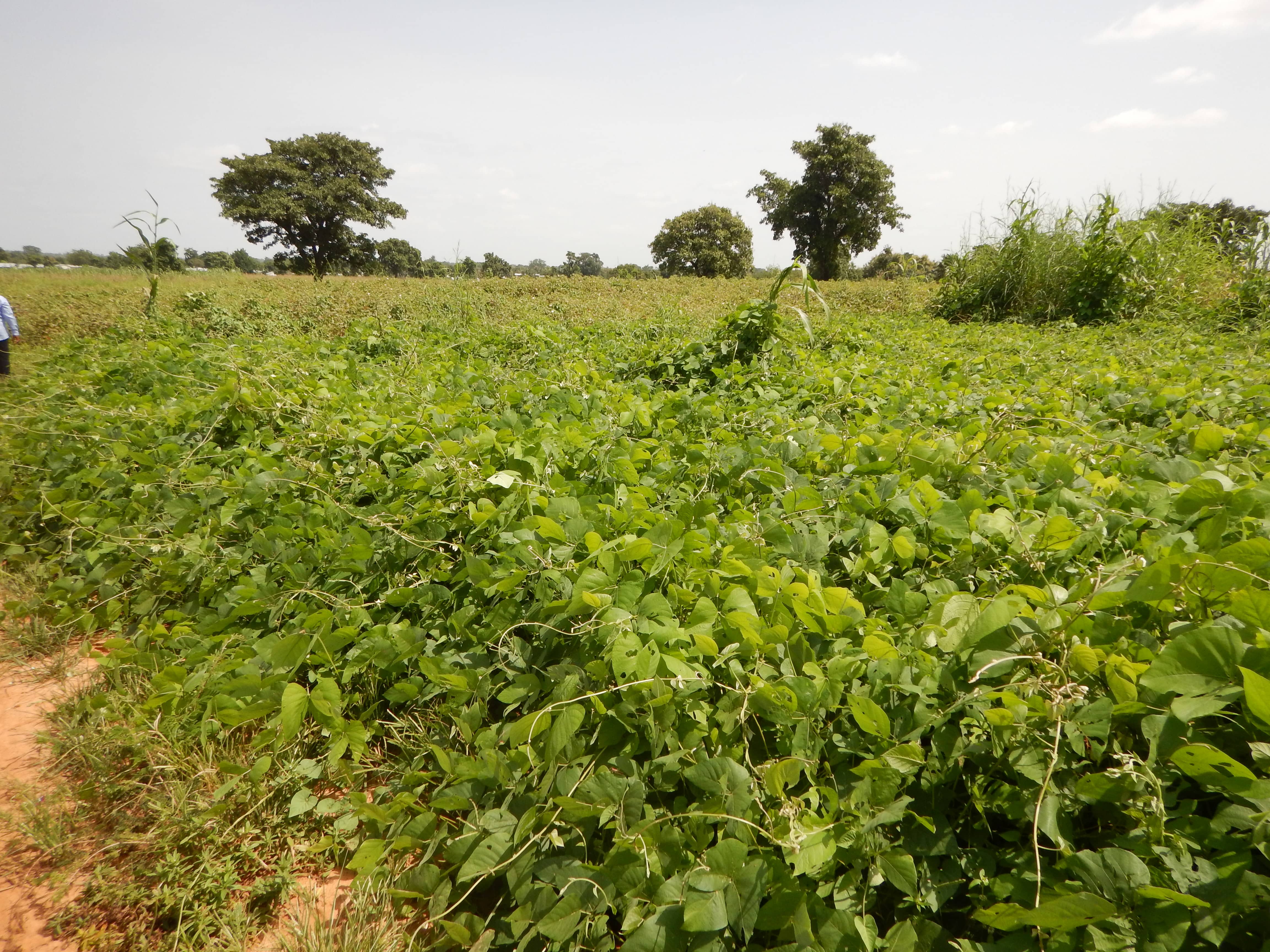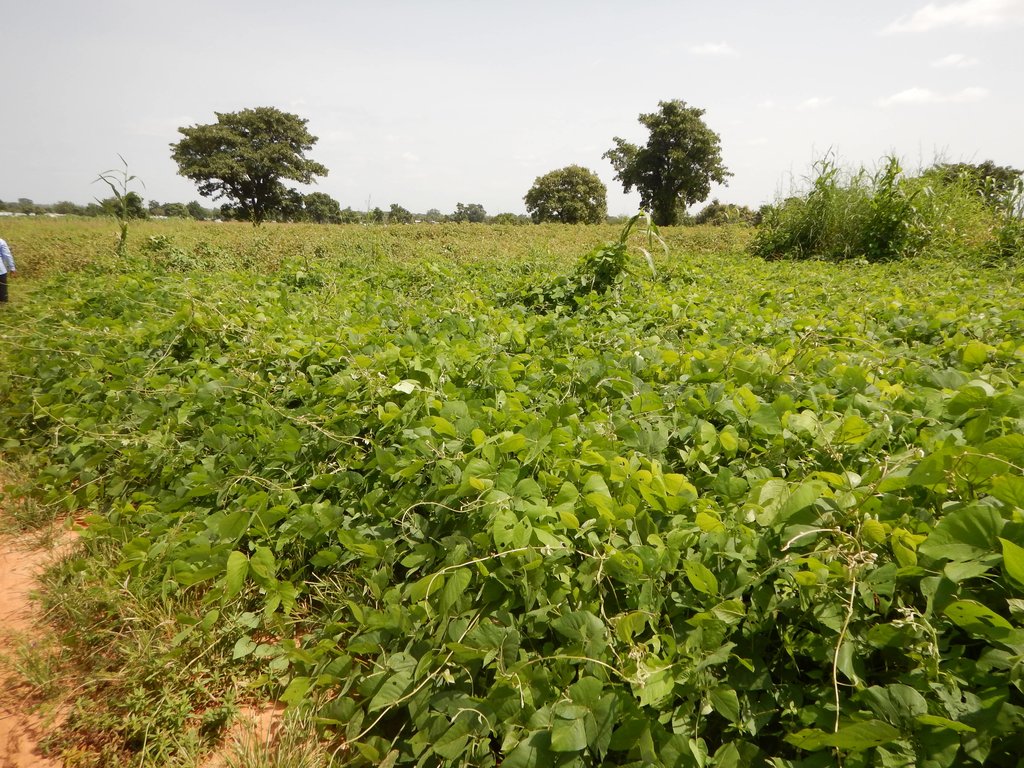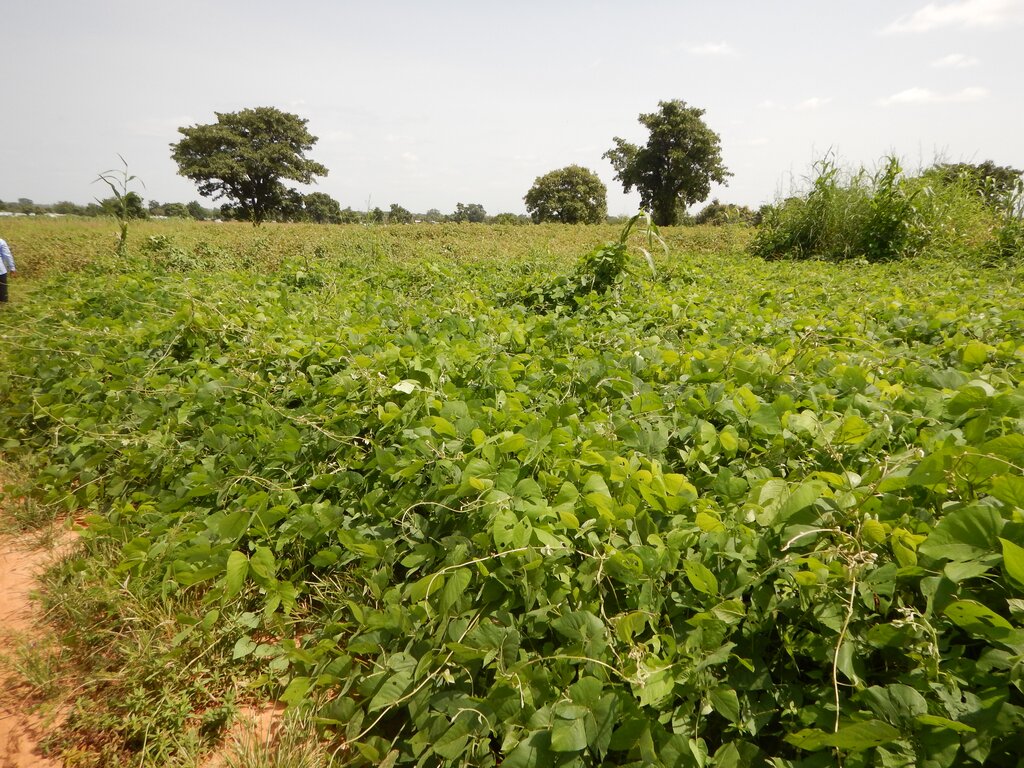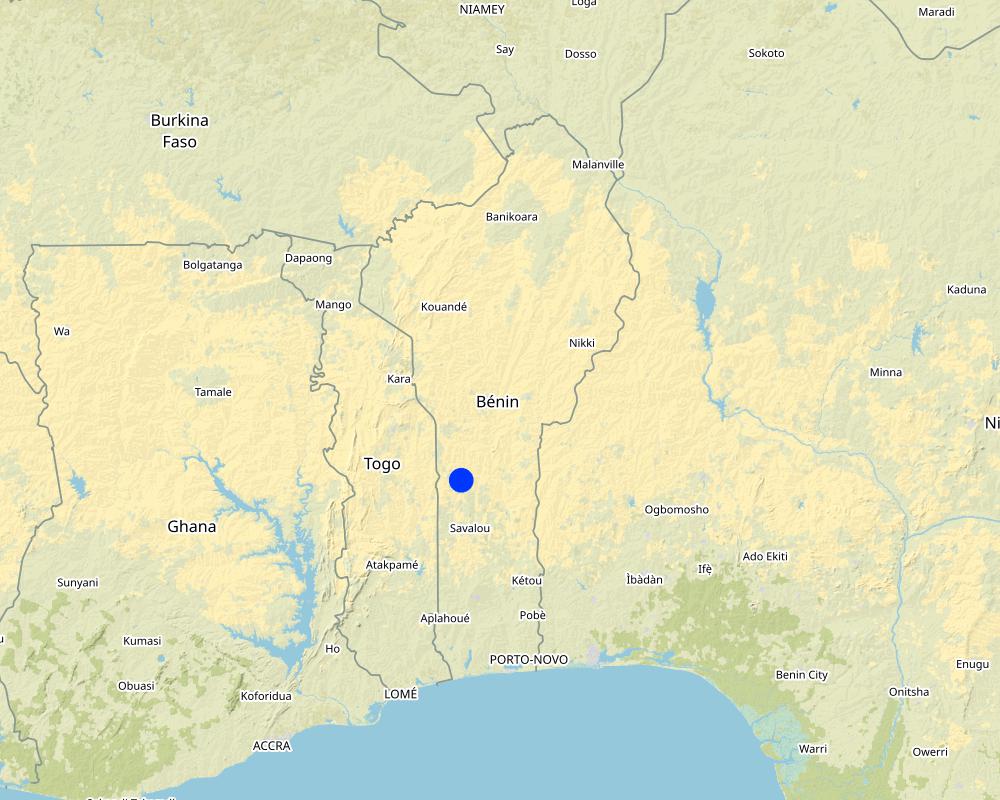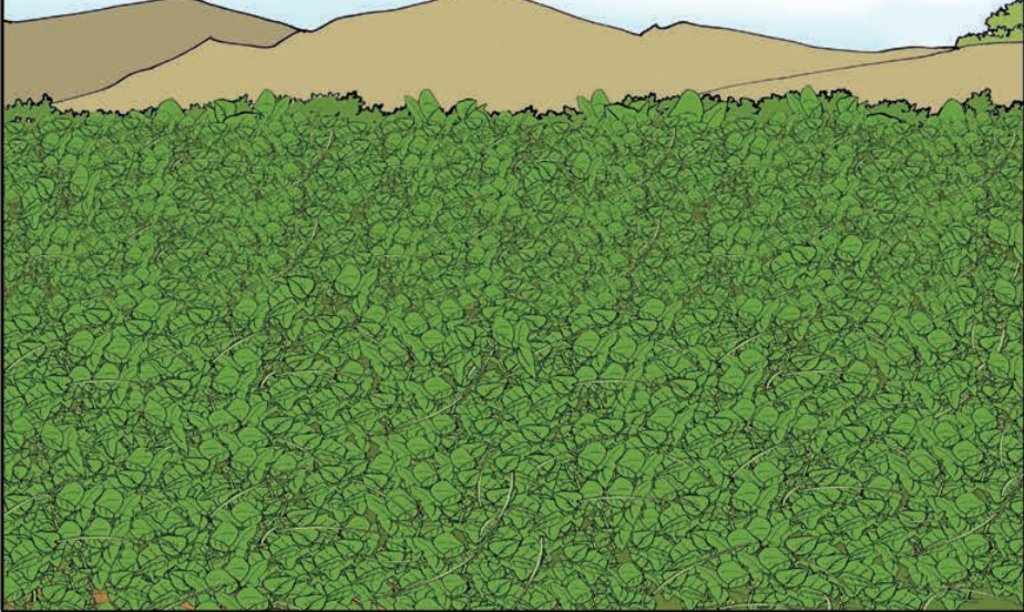Mucuna en culture de couverture pour améliorer la fertilité du sol [Benin]
- Creation:
- Update:
- Compiler: Gatien AGBOKOUN CHRISTOPHE
- Editors: Siagbé Golli, Abdoul Karim MIEN, DOSSOU-YOVO bernardin, Oscar Assa KINDEMIN, Bona Ibouratou DAFIA
- Reviewers: Sally Bunning, Rima Mekdaschi Studer
technologies_6680 - Benin
View sections
Expand all Collapse all1. General information
1.2 Contact details of resource persons and institutions involved in the assessment and documentation of the Technology
Key resource person(s)
land user:
DAGAN Lucien
CRADIB ONG
Benin
SLM specialist:
SEGNONAN Expédit
CRADIB ONG
Benin
SLM specialist:
GBEGNON Rokard
CRADIB ONG
Benin
Name of project which facilitated the documentation/ evaluation of the Technology (if relevant)
Soil protection and rehabilitation for food security (ProSo(i)l)Name of the institution(s) which facilitated the documentation/ evaluation of the Technology (if relevant)
GIZ Bénin (GIZ Bénin) - Benin1.3 Conditions regarding the use of data documented through WOCAT
The compiler and key resource person(s) accept the conditions regarding the use of data documented through WOCAT:
Yes
1.4 Declaration on sustainability of the described Technology
Is the Technology described here problematic with regard to land degradation, so that it cannot be declared a sustainable land management technology?
No
2. Description of the SLM Technology
2.1 Short description of the Technology
Definition of the Technology:
Le Mucuna (Mucuna pruriens) est une légumineuse herbacée annuelle que nous avons utilisé comme plante de couverture pour restaurer la fertilité du sol. En plus de sa capacité à fixer l’azote dans le sol, la bonne couverture végétale constitue un mulch épais qui contribue a restaurer la matière organique du sol, à capter l’eau de pluie et protéger le sol de l’érosion et à contrôler les adventices.
2.2 Detailed description of the Technology
Description:
La technologie du Mucuna en pure est appliquée par les producteurs sur des sols pauvres, enherbés (présence d’Imperata, de Striga…) ou sur des sols moyennement riches. Il s'accommode de sols sableux, argileux et même des sols très acidifiés. Il est sensible aux sols hydromorphes mais la variété Cochinchinensis (de couleur blanche) supporte les sols temporairement inondables.
Dans sa mise en place en culture pure, les producteurs sèment deux graines par poquet à un écartement de 0,80m entre lignes et 0,40m entre plants sur la ligne, ce qui nécessite 30 kg/ha de semence. Pour la première campagne lors du démarrage des appuis du projet, les semences ont été mise à la disposition des producteurs. A partir de la deuxième année, les producteurs se sont procurés en semences auprès de producteurs pairs. Le semis a lieu au début de la saison de pluies et la durée de leur cycle varie de 100 à 300 jours.
Pour l’entretien, après une bonne levée et suivant l’appréciation du degré d’enherbement, les producteurs sarclent une ou deux fois au plus les champs de mucuna. Cet entretien donne l’avantage à la légumineuse améliorante de bien s’établir pour couvrir et dominer les mauvaises herbes. Pour améliorer leur productivité, les producteurs laissent des pieds d’arbres dans les champs. Ces derniers servent de tuteurs et contribuent à augmenter le nombre d'inflorescences par plante, le nombre de fleurs par inflorescence, le nombre de graines par gousses et le taux de germination des graines récoltées. Le mucuna meurt naturellement après avoir produit des graines.
Les producteurs accompagnés constatent une amélioration des rendements des cultures installées après le mucuna. Ainsi par exemple pour le maïs, le rendement oscille autour de 2,5 à 3 tonnes à l’hectare s’il est installé sur un terrain ayant précédemment accueilli le mucuna contre 1,5 tonne pour un sol ordinaire. C’est pourquoi les producteurs l’appellent « la Plante Miracle ». A l’hectare, les producteurs ont un rendement moyen de 800kg de graines de mucuna. Ce rendement pourrait atteindre la tonne si les conditions climatiques y sont favorables et les entretiens sont faits à temps. De façon synthétique, le mucuna a des effets positifs sur diverses composantes du sol qui se présentent comme ci-après.
Entre autres avantages remarqués par les producteurs, il y a la très bonne conservation de l’humidité du sol, la protection du sol contre les rayons solaires, l’amélioration de la vie microbienne mais aussi une ource de matière organique. Aussi, constatent-ils une bonne aération du sol, bien meuble et poreux. Les feuilles constituent un bon fourrage pour les animaux notamment les moutons en stabulation qui sont vendus à l'occasion de la fête de Tabaski.
La plupart des producteurs préfèrent plus la capacité de mucuna à détruire les adventices (striga, impérata indica) et sa capacité à restaurer le sol en ses éléments nutritifs. Toutefois, le mucuna présente certains inconvénients dès qu’il est installé. Il constitue un lieu de refuge pour les reptiles en occurrence les serpents.
2.3 Photos of the Technology
2.5 Country/ region/ locations where the Technology has been applied and which are covered by this assessment
Country:
Benin
Region/ State/ Province:
Donga
Further specification of location:
Bantè
Specify the spread of the Technology:
- evenly spread over an area
If the Technology is evenly spread over an area, specify area covered (in km2):
1.0
Is/are the technology site(s) located in a permanently protected area?
No
Map
×2.6 Date of implementation
Indicate year of implementation:
2016
2.7 Introduction of the Technology
Specify how the Technology was introduced:
- through projects/ external interventions
Comments (type of project, etc.):
Le mucuna a été introduit dans la commune de Bantè par le biais du ProSOL / Bénin.
3. Classification of the SLM Technology
3.1 Main purpose(s) of the Technology
- improve production
- reduce, prevent, restore land degradation
- conserve ecosystem
- preserve/ improve biodiversity
- mitigate climate change and its impacts
- create beneficial economic impact
3.2 Current land use type(s) where the Technology is applied
Land use mixed within the same land unit:
No

Cropland
- Annual cropping
Annual cropping - Specify crops:
- oilseed crops - groundnuts
- cereals - maize
Number of growing seasons per year:
- 1
Specify:
Les producteurs font une seule récolte annuelle à cause de la saison de pluie (1 seule par an)
Is intercropping practiced?
No
Is crop rotation practiced?
Yes
If yes, specify:
Après la mise en place du mucuna, les producteurs commencent par installer les cultures sur les parcelles ayant accueilli le mucuna. Dans ce sens, ils font une rotation entre le maïs et l'arachide.
3.3 Has land use changed due to the implementation of the Technology?
Has land use changed due to the implementation of the Technology?
- Yes (Please fill out the questions below with regard to the land use before implementation of the Technology)
Land use mixed within the same land unit:
No

Cropland
- Annual cropping
Annual cropping - Specify crops:
- oilseed crops - groundnuts
- cereals - maize
Is crop rotation practiced?
Yes
If yes, specify:
La rotation se fait entre le maïs et l'arachide
3.4 Water supply
Water supply for the land on which the Technology is applied:
- rainfed
3.5 SLM group to which the Technology belongs
- rotational systems (crop rotation, fallows, shifting cultivation)
- improved ground/ vegetation cover
- integrated soil fertility management
3.6 SLM measures comprising the Technology

agronomic measures
- A1: Vegetation/ soil cover
- A2: Organic matter/ soil fertility
- A3: Soil surface treatment
A3: Differentiate tillage systems:
A 3.1: No tillage

management measures
- M1: Change of land use type
3.7 Main types of land degradation addressed by the Technology

soil erosion by water
- Wt: loss of topsoil/ surface erosion

soil erosion by wind
- Et: loss of topsoil

chemical soil deterioration
- Cn: fertility decline and reduced organic matter content (not caused by erosion)

biological degradation
- Bc: reduction of vegetation cover
- Bq: quantity/ biomass decline
- Bl: loss of soil life
3.8 Prevention, reduction, or restoration of land degradation
Specify the goal of the Technology with regard to land degradation:
- reduce land degradation
- restore/ rehabilitate severely degraded land
4. Technical specifications, implementation activities, inputs, and costs
4.1 Technical drawing of the Technology
Technical specifications (related to technical drawing):
Notre pluviométrie est de 1323 mm et les températures moyennes de 19,5°c en saison culturale de Mai à Octobre (ce qui entre dans les 1000 à 2500 mm, et températures de 19 à 27°C, demandé par la plante). Nous avons effectué un écartement de de 0,4m x 0,8m dans son installation respectivement entre poquets et entre ligne. Lors du semis, il faut mettre 2 à 3 graines par poquet, ce qui donne une densité moyenne de 23437 plants à 93750 plants par hectare. La quantité de semence pour un 1 hectare, il faut en moyenne 25 à 30 kg de semence. Son semis doit s’opérer entre le mois de juin et au plus tard en juillet.
Author:
ProSOL Bénin
4.2 General information regarding the calculation of inputs and costs
Specify how costs and inputs were calculated:
- per Technology area
Indicate size and area unit:
1ha
other/ national currency (specify):
Franc CFA
If relevant, indicate exchange rate from USD to local currency (e.g. 1 USD = 79.9 Brazilian Real): 1 USD =:
615.0
4.3 Establishment activities
| Activity | Timing (season) | |
|---|---|---|
| 1. | Defrichage | Mai - Juin |
| 2. | Labour | Juin - Juillet |
| 3. | Semis | Juin - Juillet |
4.4 Costs and inputs needed for establishment
| Specify input | Unit | Quantity | Costs per Unit | Total costs per input | % of costs borne by land users | |
|---|---|---|---|---|---|---|
| Labour | Défrichage | ha | 1.0 | 17500.0 | 17500.0 | 100.0 |
| Labour | Labour | ha | 1.0 | 25000.0 | 25000.0 | 100.0 |
| Labour | Semis | ha | 1.0 | 10000.0 | 10000.0 | 100.0 |
| Labour | ha | 1.0 | 20000.0 | 20000.0 | 100.0 | |
| Equipment | 100.0 | |||||
| Equipment | 100.0 | |||||
| Equipment | Daba | Unité | 1.0 | 4000.0 | 4000.0 | 100.0 |
| Equipment | Houe | Unité | 1.0 | 3000.0 | 3000.0 | 100.0 |
| Plant material | Semences | Kilogramme | 30.0 | 500.0 | 15000.0 | |
| Total costs for establishment of the Technology | 94500.0 | |||||
| Total costs for establishment of the Technology in USD | 153.66 | |||||
4.5 Maintenance/ recurrent activities
| Activity | Timing/ frequency | |
|---|---|---|
| 1. | Sarclage | Juillet - Aout |
| 2. | Récolte | Novembre - Décembre |
| 3. | Battage | Décembre |
| 4. | Réalisation de Pare feu | Novembre - Décembre |
4.6 Costs and inputs needed for maintenance/ recurrent activities (per year)
| Specify input | Unit | Quantity | Costs per Unit | Total costs per input | % of costs borne by land users | |
|---|---|---|---|---|---|---|
| Labour | Sarclage | ha | 1.0 | 20000.0 | 20000.0 | 100.0 |
| Labour | Récolte | ha | 1.0 | 12500.0 | 12500.0 | 100.0 |
| Labour | Battage | ha | 1.0 | 12500.0 | 12500.0 | 100.0 |
| Labour | Réalisation de Pare feu | ha | 1.0 | 12500.0 | 12500.0 | 100.0 |
| Total costs for maintenance of the Technology | 57500.0 | |||||
| Total costs for maintenance of the Technology in USD | 93.5 | |||||
4.7 Most important factors affecting the costs
Describe the most determinate factors affecting the costs:
La main d'oeuvre salariée pour la récolte est un facteur limitant
5. Natural and human environment
5.1 Climate
Annual rainfall
- < 250 mm
- 251-500 mm
- 501-750 mm
- 751-1,000 mm
- 1,001-1,500 mm
- 1,501-2,000 mm
- 2,001-3,000 mm
- 3,001-4,000 mm
- > 4,000 mm
Specify average annual rainfall (if known), in mm:
1323.00
Agro-climatic zone
- sub-humid
5.2 Topography
Slopes on average:
- flat (0-2%)
- gentle (3-5%)
- moderate (6-10%)
- rolling (11-15%)
- hilly (16-30%)
- steep (31-60%)
- very steep (>60%)
Landforms:
- plateau/plains
- ridges
- mountain slopes
- hill slopes
- footslopes
- valley floors
Altitudinal zone:
- 0-100 m a.s.l.
- 101-500 m a.s.l.
- 501-1,000 m a.s.l.
- 1,001-1,500 m a.s.l.
- 1,501-2,000 m a.s.l.
- 2,001-2,500 m a.s.l.
- 2,501-3,000 m a.s.l.
- 3,001-4,000 m a.s.l.
- > 4,000 m a.s.l.
Indicate if the Technology is specifically applied in:
- not relevant
5.3 Soils
Soil depth on average:
- very shallow (0-20 cm)
- shallow (21-50 cm)
- moderately deep (51-80 cm)
- deep (81-120 cm)
- very deep (> 120 cm)
Soil texture (topsoil):
- coarse/ light (sandy)
- medium (loamy, silty)
Soil texture (> 20 cm below surface):
- coarse/ light (sandy)
Topsoil organic matter:
- high (>3%)
5.4 Water availability and quality
Ground water table:
5-50 m
Availability of surface water:
good
Water quality (untreated):
good drinking water
Water quality refers to:
ground water
Is water salinity a problem?
No
Is flooding of the area occurring?
No
5.5 Biodiversity
Species diversity:
- medium
Habitat diversity:
- medium
5.6 Characteristics of land users applying the Technology
Sedentary or nomadic:
- Sedentary
Market orientation of production system:
- mixed (subsistence/ commercial)
Off-farm income:
- less than 10% of all income
Relative level of wealth:
- poor
- average
Individuals or groups:
- groups/ community
Level of mechanization:
- manual work
Gender:
- women
- men
Age of land users:
- youth
- middle-aged
5.7 Average area of land used by land users applying the Technology
- < 0.5 ha
- 0.5-1 ha
- 1-2 ha
- 2-5 ha
- 5-15 ha
- 15-50 ha
- 50-100 ha
- 100-500 ha
- 500-1,000 ha
- 1,000-10,000 ha
- > 10,000 ha
Is this considered small-, medium- or large-scale (referring to local context)?
- small-scale
- medium-scale
5.8 Land ownership, land use rights, and water use rights
Land ownership:
- communal/ village
Land use rights:
- communal (organized)
Water use rights:
- communal (organized)
Are land use rights based on a traditional legal system?
Yes
Specify:
La terre appartient aux familles : les Collectivités
5.9 Access to services and infrastructure
health:
- poor
- moderate
- good
education:
- poor
- moderate
- good
technical assistance:
- poor
- moderate
- good
employment (e.g. off-farm):
- poor
- moderate
- good
markets:
- poor
- moderate
- good
energy:
- poor
- moderate
- good
roads and transport:
- poor
- moderate
- good
drinking water and sanitation:
- poor
- moderate
- good
financial services:
- poor
- moderate
- good
6. Impacts and concluding statements
6.1 On-site impacts the Technology has shown
Socio-economic impacts
Production
crop production
Quantity before SLM:
500kg/ha
Quantity after SLM:
3t/ha
Comments/ specify:
500 kg/ha de maïs (parcelle sans mucuna), 3 t/ha de maïs (parcelle avec mucuna).
crop quality
Comments/ specify:
Les produits sont naturellement enrichis et non à base d'engrais chimique
fodder production
Comments/ specify:
Les feuilles constituent un bon fourrage pour les animaux notamment les moutons en stabulation qui sont vendus à l'occasion de la fête de Tabaski.
production area
Comments/ specify:
L'application de la mesure a permis d'étendre la production du maïs sur des terres jadis jugée très pauvre
land management
Income and costs
expenses on agricultural inputs
Comments/ specify:
On n'utilise quasiment plus d'engrais sur les terres où le mucuna a été semée
farm income
Comments/ specify:
L'amélioration des rendements et la non utilisation des engrais minéral
Socio-cultural impacts
food security/ self-sufficiency
Comments/ specify:
L'augmentation de la production contribue à améliorer la situation de sécurité alimentaire des producteurs
health situation
Comments/ specify:
L'amélioration des rendements permet aux producteurs de pouvoir gagner plus d'argent et donc de lui faciliter à de meilleurs soins
SLM/ land degradation knowledge
Ecological impacts
Soil
soil moisture
Comments/ specify:
Le paillis que constitue le mucuna facilite une très bonne conservation de l’humidité du sol
soil cover
Comments/ specify:
Le mucuna permet une protection du sol contre les rayons solaires
soil loss
Comments/ specify:
Améliore la fertilité du sol
soil organic matter/ below ground C
Comments/ specify:
Contribue énormément à l'amélioration de la fertilité des sols d'où son surnom de Plante Miracle
Biodiversity: vegetation, animals
Vegetation cover
biomass/ above ground C
invasive alien species
Comments/ specify:
Il limite et bloque la croissance des adventices
Climate and disaster risk reduction
wind velocity
micro-climate
6.3 Exposure and sensitivity of the Technology to gradual climate change and climate-related extremes/ disasters (as perceived by land users)
Gradual climate change
Gradual climate change
| Season | increase or decrease | How does the Technology cope with it? | |
|---|---|---|---|
| annual temperature | increase | moderately | |
| seasonal temperature | dry season | increase | moderately |
| annual rainfall | increase | not well | |
| seasonal rainfall | dry season | increase | moderately |
Climate-related extremes (disasters)
Climatological disasters
| How does the Technology cope with it? | |
|---|---|
| drought | moderately |
6.4 Cost-benefit analysis
How do the benefits compare with the establishment costs (from land users’ perspective)?
Short-term returns:
very positive
Long-term returns:
positive
How do the benefits compare with the maintenance/ recurrent costs (from land users' perspective)?
Short-term returns:
very positive
Long-term returns:
positive
6.5 Adoption of the Technology
- > 50%
Of all those who have adopted the Technology, how many did so spontaneously, i.e. without receiving any material incentives/ payments?
- 11-50%
Comments:
Il s'agit ici de ceux qui systématiquement après les formations ont préparé les sols pour l'installation du Mucuna et qui étaient prêts à payer la semence par eux-mêmes.
6.6 Adaptation
Has the Technology been modified recently to adapt to changing conditions?
No
6.7 Strengths/ advantages/ opportunities of the Technology
| Strengths/ advantages/ opportunities in the land user’s view |
|---|
| Amélioration la fertilité du sol |
| Amélioration du rendement |
| Limitation de l’érosion |
| Capacité du contrôle des adventices |
| Capacité de conservation de l’humidité de sol |
| L’alimentation des animaux (ruminants) |
| Strengths/ advantages/ opportunities in the compiler’s or other key resource person’s view |
|---|
| L’augmentation de la vie microbienne |
| Conservation de l’humidité du sol |
| Augmentation de la biomasse constituant de l’engrais vert |
| Réduction de dépenses pour les intrants agricoles |
6.8 Weaknesses/ disadvantages/ risks of the Technology and ways of overcoming them
| Weaknesses/ disadvantages/ risks in the land user’s view | How can they be overcome? |
|---|---|
| Vitesse très lente de restauration du sol | Cibler progressivement les espaces de terres pauvres pour installer le mucuna |
| Attraction des reptiles | Se munir de bottes et de gants |
| Weaknesses/ disadvantages/ risks in the compiler’s or other key resource person’s view | How can they be overcome? |
|---|---|
| Difficultés d’entretien, éclatement brusque des gousses | Faire la récolte avant l’apparition de l’harmattan |
7. References and links
7.1 Methods/ sources of information
- field visits, field surveys
1
- interviews with land users
1
- interviews with SLM specialists/ experts
2
- compilation from reports and other existing documentation
7
When were the data compiled (in the field)?
19/01/2023
7.2 References to available publications
Title, author, year, ISBN:
Deutsche Gesellschaft für Internationale Zusammenarbeit (GIZ) GmbH, 2018, Compendium de fiches techniques du formateur
Title, author, year, ISBN:
Amadji F., Ahouanton K., Tarawali S. 2003. Fiche technique illustrée –Mucuna pour une amélioration durable de la fertilité du sol et des rendements au centre et au sud du Bénin. INRAB, ILRI, IITA, 2 p
Title, author, year, ISBN:
AZONTONDE A. H., FELLER C., REMY J.-C., 1998. Le mucuna et la restauration des propriétés d'un sol ferraiIitique au sud du Bénin
Available from where? Costs?
https://agritrop.cirad.fr/390388/1/document_390388.pdf
Title, author, year, ISBN:
BALOGOUN I., OGOUDJOBI S. L., OROU BERO E., DAHODO B., VIDINHOUEDE R. et HOUNGNANDAN P., 2022. Performance agronomique du Mucuna pruriens sur la culture du maïs et la fertilité chimique des sols ferralitiques au Sud-Bénin
Available from where? Costs?
http://ajol.info/index.php/ijbcs
Title, author, year, ISBN:
AKLAMAVO M., MENSAH G.A. 1997. Quelques aspects de l'utilisation du mucuna en milieu rural en République du Bénin. Bulletin de la Recherche Agronomique 9 : 34-46.
Available from where? Costs?
http://www.slire.net/download/1106/aklamavo_bra_019_1997-3.pdf
Title, author, year, ISBN:
Barthès B., Azontonde A. et Feller C., 2017. Effets du Mucuna sur la production et la durabilité de systèmes de culture à base de maïs au Sud-Bénin
Available from where? Costs?
https://books.openedition.org/irdeditions/24384?lang=fr
Title, author, year, ISBN:
ALLAGBE M., DJINADOU A. K. A., BANKOLE C., HINVI J., AZELOKONON O., HOUNTONDJI A. Y., ADJANOHOUN A., JALLOH A.; 2015. Association maïs-mucuna pour une gestion durable de l'humidité et de la fertilité des sols au Sud et au Centre du Bénin
Available from where? Costs?
https://www.researchgate.net/publication/331861866_FICHE_TECHNIQUE_07
Links and modules
Expand all Collapse allLinks
No links
Modules
No modules


